Podcasts have become increasingly popular in recent years, as they’ve proven to be an effective content marketing strategy for individuals and brands alike.
If you’ve been considering getting your start in the ever-evolving world of podcasting, you might feel overwhelmed by the idea of launching your own program. We’re here to clear up any confusion and show you that beginning is likely easier than you think!
In this step-by-step guide, we’ll take you through all the necessary steps of starting a podcast to ensure that you’re on the right track.
1. Decide on a podcast topic
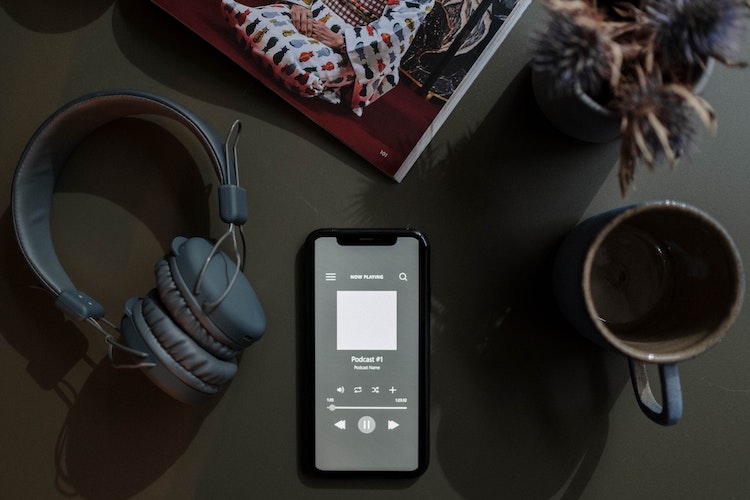
When you want to start a podcast, the first step is to decide on a topic. It’s important to take your time when choosing your podcast theme, as this will have a significant effect on your ability to stay committed to your show for the long term and attract subscribers.
To begin, think about what you’re passionate about. It’s essential that the theme of your podcast is something that you enjoy discussing. Although you don’t have to be an expert on the topic, you should have a decent amount of knowledge about it, as you’ll want to sound like you know what you’re talking about!
You might already have an idea in mind for your podcast, but remember that in order to boost your chances of success, your topic should have plenty of longevity. Maybe you’re super excited about your idea today, but will you still be able to create high-quality, engaging episodes based on that same theme a year down the road?
Although it’s impossible to predict with 100% certainty how successful your podcast will be, one way to gauge the likely longevity of your potential subject is to see if you’re able to create a list of around 25 episode ideas based on said theme. What would you talk about during each episode? Who would you like to interview (if you plan to include other people in your podcast)?
If you struggle to complete your list of 25 ideas for episodes, it’s a strong sign to go back to the drawing board and work on brainstorming a podcast topic that’ll have more staying power!
Also note that rather than having your podcast revolve around a very generic theme, it’s best to narrow it down to a more specific niche to assist you in attracting an audience that’s more engaged in your content. For instance, rather than launching a podcast about gardening, consider a more specific subcategory, like rose care, urban gardens, beginner gardening, etc.
Once you have a better idea of what kind of podcast you want to create, ask yourself a few questions to ensure that you’re starting off on the best track possible.
Why do you want to start a podcast?
Perhaps you have a burning passion for a particular subject and want to begin podcasting simply because you enjoy talking about it. Or maybe you’re a freelancer or have your own ecommerce business and want to launch a podcast as part of your content marketing strategy to increase authority, grow your community, and ultimately boost product or service sales.
Determining your reasons for starting a podcast will help you to better design content that aligns with your specific goals and stay motivated over time, even after you’ve recorded hundreds of episodes!
Who is your podcast for?
In order to boost your chances of growing your audience, you’ll also need to figure out who you wish to target with your show. This is especially crucial if your reasons for starting a podcast are more business related rather than just personal, such as if you want to sell courses online.
Think about what’s important to the people you hope to reach with your podcast. What are their beliefs, concerns, and interests? Keeping your listeners at the forefront of your content strategy will allow you to create episodes that better resonate with them.
How will your podcast stand out from the competition?
Even if you have endless amounts of enthusiasm for your topic, you’ll still need to find a way to differentiate your show from other podcasts if you want to attract subscribers. Consider what unique attributes you bring to the table that’ll make people want to tune in to your podcast.
Maybe your show involves a really cool, specific niche, for example. Or perhaps you can offer an interesting new perspective on a hot topic or have an engaging personality that’ll draw people into the conversation.
2. Select your podcast format
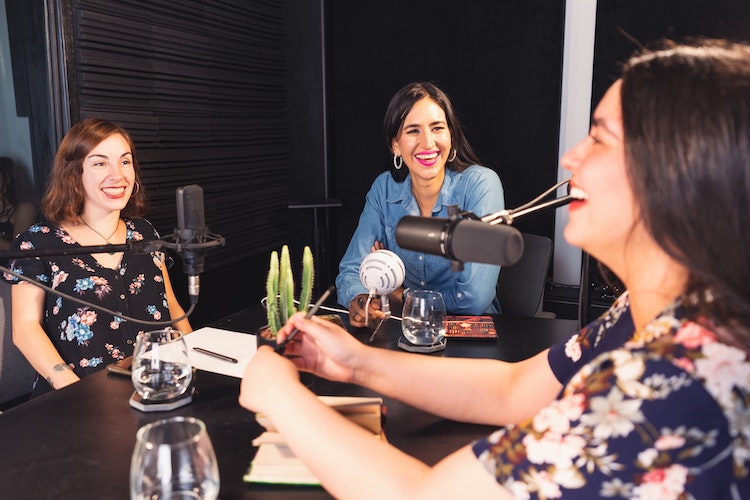
In this next step, you’ll select your podcast format and decide how you want to structure it. The format of your podcast should make sense for your chosen topic and be easily achievable for the long term.
When determining the best format for your podcasting adventure, also ask yourself if you prefer to go at it alone or have a co-host. If you decide to collaborate with others, aim to keep your number of co-hosts to a minimum, as trying to schedule recording sessions with more than two or three people can get tricky.
In addition, consider your budget and time constraints, as some formats will require you to edit more and spend more time in production than others. While you can always update and add more to your podcast as it grows, trying to do too much in the beginning when you don’t have the right resources can quickly become overwhelming and lead to you quitting your podcasting efforts just barely after you’ve started.
To help you to better decide on the best podcast format for your specific needs, here are brief descriptions of some of the most popular options.
- Educational: The principal objective of this type of podcast is to teach your audience about a particular subject. With topics involving everything from languages and history to nutrition, pet care, DIY tips, finance, and much more, educational podcasts make it possible for those listening to gain knowledge on the go. Example: Let’s Talk About Myths, Baby!
- Interviews: With this format, you as the host will interview another person or several people in line with a certain theme during each episode. This type of podcast has the advantage of providing a variety of perspectives, which can add more interest for subscribers. Example: The Morning Shakeout
- News: Here, you’ll give your audience a recap of the latest happenings concerning your specific theme. This format appeals to listeners who want to get their news in a quick, easily digestible way. Example: The Daily by The New York Times
- Scripted fiction: Often involving a high level of production, podcasts in this category captivate subscribers with their exciting stories and engaging voice acting. If you love writing mysteries, comedies, sci-fi adventures, romance tales, or any other creative fictional works, this might be an ideal format for you. Example: The Amelia Project
- Scripted non-fiction: This podcast format includes pre-written episodes featuring true stories and can involve a variety of topics, such as historical events or anything in the true crime genre. You can opt to narrate your podcast yourself, hire voice actors to act out the script, or use a combination of the two tactics, depending on what best suits your specific audience. Example: The Dream
Besides deciding on the structure of your podcast, you’ll also need to determine the length and frequency of your episodes. When it comes to episode length, it’s important to create episodes that are long enough to provide your listeners with valuable content but not so long that your audience gets bored.
According to Buzzsprout, the largest percentage (32%) of podcasts are between 20 and 40 minutes long, with the duration window of 40–60 minutes coming in second place (21%). However, the best length for your show depends on your ideal listener’s needs and habits.
For instance, are the people in your audience going to tune in to your podcast during their commute to work/school? If so, how long does their commute usually last? Or perhaps instead they’re more likely to listen to your show while working out at the gym or going for a run. Having a good understanding of their daily routines can help you design content that’ll fit nicely into their schedules.
In terms of the optimal frequency of your podcast, consider how much time you realistically have to devote to all the researching, writing, recording, and editing required for each episode. A higher rate of publishing won’t necessarily make your show more successful if you can’t maintain this schedule on a regular basis.
The majority of podcasts tend to be published around once a week or once every two weeks. Nevertheless, podcast listeners tend to appreciate consistency and predictability, so you should aim to use a publishing schedule that you can easily maintain. Remember that you can always start to publish more frequently if your resources allow as your show gets bigger.
3. Build your podcast brand

The third step of getting started with podcasting is to begin to build your podcast brand. This step can take some time, but avoid the temptation to rush through it. Putting thought into your branding and its development is well worth the effort, as you’ll want to make a good first impression with people new to your show.
Select a name for your podcast
The name of your podcast is obviously going to be pretty important, as it’ll be the first thing potential listeners come across before they tune in to a single episode. Fortunately, there are several strategies you can use when naming your podcast.
If you already have an established brand, say via your blog, ecommerce site, or social networks, you might just use that and simply add another word, like “podcast” or “show” to give it some context and differentiate it from your other content.
Another option is to pick a searchable, descriptive title that makes it clear what your show is about. By including the specific keywords that your target audience is likely to be searching for, you’ll boost your chances of having your show appear higher up in the search engine results. Just be careful not to try to cram too many keywords in there, as Google isn’t a fan of keyword stuffing.
You can alternatively choose a name that doesn’t necessarily explain your podcast’s theme but is fun and/or witty. Note that while using a catchy title can be a helpful tactic to make your show stand out, it may become a little trickier getting new listeners, as they probably won’t immediately know what kinds of topics your podcast is going to discuss. If you opt to go this route, try to add a descriptive tagline that clues people in as to what they can expect from your show.
However you decide to go about naming your podcast, try to pick a title that is succinct yet is going to pique a potential listener’s curiosity. It’s generally best to ensure that the name of your program is no longer than four words, and it should be memorable and easy to say, keeping in mind that you’ll be mentioning the name of your podcast quite often yourself!
One last point about picking a name… Before you become too attached to a particular title, check to see that it’s indeed still available and hasn’t already been taken by somebody else. To confirm your idea’s availability, you can take a look at the various podcast directories, your local/national patent and trademark offices, social media, and Google.
Decide on a podcast category
The next step of building your brand entails selecting the category that best suits your program. Podcast categories are what directories such as Spotify, Apple Podcasts, and Google Podcasts use to display relevant content to users.
Choosing a category that accurately reflects your podcast theme is essential, as your potential audience members are likely to glance through their favorite categories when they want to discover new shows. If you pick a category that has nothing to do with what you discuss on your program, you risk frustrating potential new listeners or even having the directories remove your podcast.
According to a study by Spotify, the fastest growing podcast categories in many areas of the world involve both mental and physical self-improvement, including Health & Fitness, Religion & Spirituality, Music, and History.
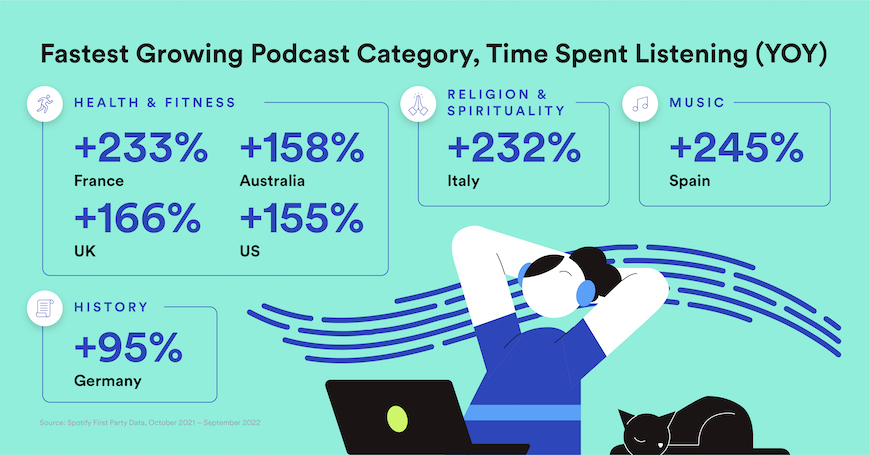
Source: Spotify 2022 Podcast Trends Report
Depending on your chosen hosting platform, you’ll probably need to select at least one primary category but have the option of adding multiple subcategories.
To help you better determine the right category or categories for your show, ask yourself what you consider to be the main focus in terms of topics on your podcast. You can also think about what kinds of other podcasts you’d like your program to appear next to and which shows are similar to yours regarding target audience, interests, ideology, etc.
Write your podcast description
Also known as a “show summary,” a podcast description describes exactly what your show is all about. While podcasters are sometimes tempted to rush through the writing of this text, I urge you to give your description a decent amount of your time and attention.
Although potential listeners will first see the name of your podcast when they discover your show, the description is what they’ll read to find out if it sounds appealing. So how do you craft a high-quality summary that’ll make people want to click on your podcast and start listening?
- Speak directly to your target audience: Help them feel seen and understood. Your description should make them feel like you “get” them.
- Explain why they should listen to your show: Clearly state the benefits of your podcast and how your program can improve your listeners’ lives.
- Introduce yourself: You don’t have to be a celebrity to become successful in podcasting, but providing a bit of background information about yourself, such as your expertise and/or why you created the show, can strengthen the connection people feel with you and your brand.
- Describe what your podcast offers: Let potential listeners know what they can expect with your show, such as the theme(s), format, frequency of episodes, etc.
- Ensure that your description is succinct, yet complete: Although there’s no one-size-fits-all solution in terms of summary length, the best approach is generally to get your message across without being overly verbose.
Note: While it’s important that you take the time to write a good description for your program, it doesn’t have to be perfect. You can edit your description any time you’d like, so there’s no need to stress too much over this part of the process!
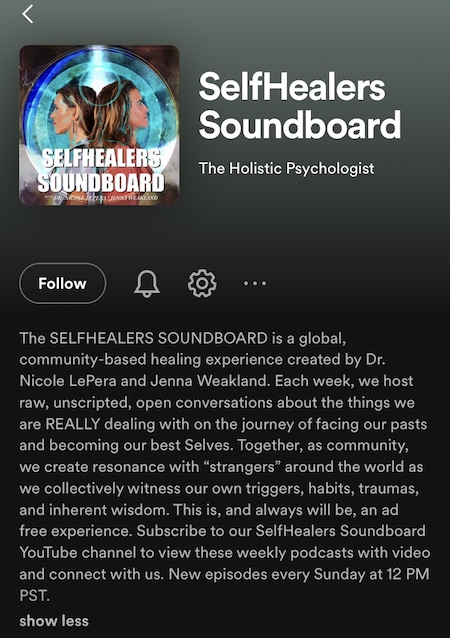
Podcast description for the SelfHealers Soundboard
Create your podcast cover art
Despite the fact that podcasting is mostly associated with sound and listening, there’s also a visual element involved in building a podcast brand: the cover art.
The cover art for your show is part of the first impression you offer to potential listeners and should therefore be visually appealing, clearly convey the theme of your program, and make it possible for your podcast to stand out in the sea of podcasts available on the various platforms.
Creating your cover art is free and easy with the Canva tool, which even offers logo templates designed for podcasts to make the creation process even simpler. Another possibility is to hire a freelancer via a site such as Fiverr or Upwork to design your cover art for you.
To guide you in creating a great visual for your show, here are few effective strategies to implement:
- Add a minimal amount of text: Don’t forget that many users are going to view your cover art as a thumbnail, so it’s best to avoid filling it up with lots of words. The only text that’s really necessary is the title of your podcast.
- Verify the technical specifications required by your chosen directory: The technical specifications for podcast cover art vary across the various directory options, so it’s a good idea to check these before you create your design. That being said, general guidelines to follow include creating a square visual that’s between 1400 x 1400 px and 3000 x 3000 px and is in a JPEG or PNG format.
- Be consistent with your branding: While you may need to create various versions of your artwork to accommodate different pages, the imagery used for each design should be the same. Consistent branding is going to give your podcast a more professional image and can help people to better remember your show.
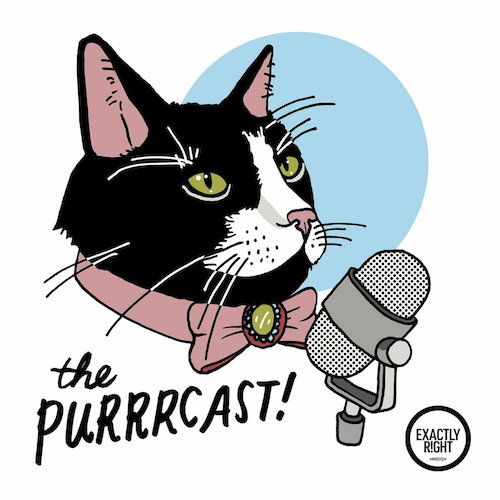
Cover art for The Purrrcast
4. Set up your recording equipment
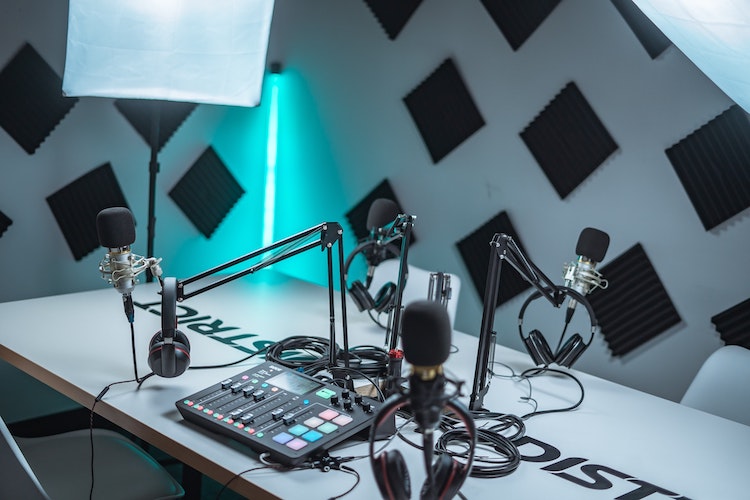
After working on your podcast brand, you’ll next need to make sure that you have all the equipment required to record your show. Sound quality is very important when it comes to successful podcasting, as subscribers won’t hesitate to stop listening if they can’t hear you very well or if your audio sounds less than professional.
Note that before you rush out to buy any recording equipment, you’ll want to have a good understanding of what you want your setup to involve. For instance, are you going to be recording your audio on the go, at home, or in a studio? Microphones pick up sound differently depending on the environment, so it’s best to go for equipment that’ll give you quality sound regardless of where you’re recording.
In addition, are you going to be hosting your show by yourself or have a co-host? Do you plan to interview guests? If multiple people will be recording, remember to have enough equipment on hand for everybody.
Don’t forget to also set a budget for your audio recording equipment…and stick to it!
These days, podcasters have a wide range of products from which to choose for all their recording needs, making it possible to get started even with limited financial resources. If you’re opposed to spending a lot of money in the beginning, you can opt to buy the best quality items you can comfortably afford, remembering that you can always upgrade as your podcast grows.
However you decide to set up your recording sessions, here are some of the tools that can aid in creating a stellar podcast.
Microphone
To begin, you’ll need to have a microphone for each host and/or guest on your show. When researching different mic possibilities for podcasts, you’ll discover that there are two main groups: condenser and dynamic.
- Condenser: Condenser mics are great for picking up a wide range of frequencies and producing high-quality audio. However, their extra sensitivity means that you’ll have to record in a very quiet space. In addition, you’ll need to have some sort of external power on hand to operate this kind of microphone.
- Dynamic: Dynamic mics don’t require external power and are usually a little more budget friendly than their condenser counterparts. They’re also less sensitive, which means that you generally won’t have as much background noise to worry about removing during the editing process. A drawback to this lack of sensitivity, though, is that you’ll have to ensure that your mouth is close to the mic when you talk to maintain consistency while recording.
Another factor to consider during the process of selecting the right podcast microphone is the kind of connection you want to use.
- USB: USB mics are easy to work with and allow for a simple setup, as you can plug them directly into your computer or plug them into an interface if you have guests and/or multiple hosts present during recording. They tend to have a lower price point than XLR options but also have a lower sound quality.
- XLR: XLR mics offer more control over your recording and usually last for a long time. That being said, they’re often more expensive and need to be hooked up to an audio interface or mixer, increasing the cost of your equipment setup.
Microphone stand or boom arm
When you’re recording, you won’t want to be holding your mic throughout the whole session. Using a microphone stand for your desk or a boom arm allows you to keep the mic close by and prevent it from moving around and picking up extra noise. Furthermore, you’ll also be able to keep your hands free in case you want to use them to check something on your laptop, take a photo with your phone, gesticulate, etc.
Shock mount
To better steady your mic and avoid excess movement, you can purchase a shock mount for your recording setup. This handy item ensures that the microphone is securely attached to the arm, preventing vibrations that can mess with your audio. You can get a shock mount specifically designed for your mic or a universal version that works with any mic model.
Headphones
Wearing headphones while recording makes it possible for you to monitor and adjust the quality of your sound as you go. It also allows you to better hear your guests and/or co-hosts and assist you when you edit. Opt for over-the-ear headphones rather than earbuds, as they’re generally more comfortable and better at rejecting noise.
Audio interface
Less important to your setup if you’re using USB mics, an audio interface is required if you plan to use XLR mics or want separate tracks when recording with multiple hosts/guests. An audio interface makes it possible for you to connect your equipment and your computer with ease.
Audio mixer
While you won’t need to invest in a mixer if you’re new to podcasting and only interested in putting together a basic equipment setup, it may be something to consider if your recording situation is a bit more complex and you want to take your sound to the next level. If you have multiple speakers or want to record various kinds of audio, an audio mixer can be a great tool to have on hand.
Pop filter
Although having a pop filter isn’t crucial to podcasting, it can help give your audio a smoother, more professional sound. As you record, you’ll need to be close to the microphone when you speak. A pop filter serves as a barrier between you and the mic to reduce plosives, the tones we tend to naturally make when saying words with harsh consonant sounds.
Video camera
While podcasting definitely focuses on auditory aspects, the addition of visual elements can create an even better experience for the listener. To boost engagement with your show, consider adding simple or complex video content, like a static image or even a complete video recording of your show’s hosts and guests. For this, it’s advantageous to invest in a decent camera for filming, keeping in mind that you’ll need more than one if you plan to capture multiple angles.
Lighting
If you do decide to film your show, you’ll also want to take care of your lighting situation to ensure that those listening can see you. Purchasing lighting may not be necessary if you’re lucky enough to have a recording location with great natural lighting or one where a simple ring light will do the trick. However, if you’re in a darker room, a professional lighting kit can really transform the space.
5. Obtain podcast recording and editing software
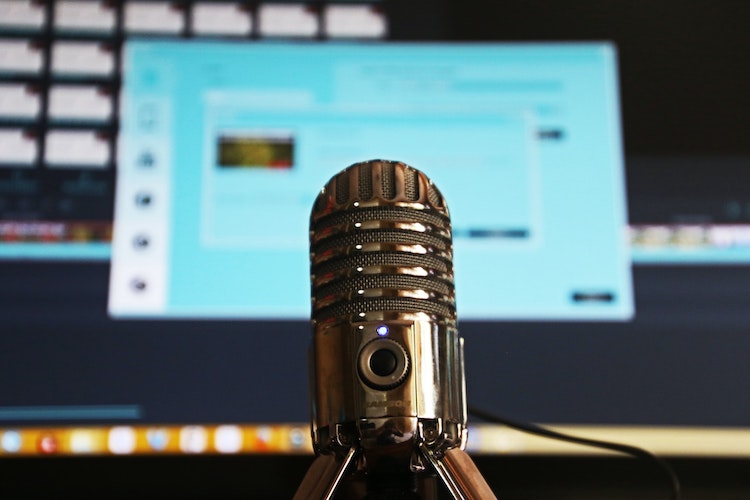
Besides the recording equipment mentioned above, you’ll need to obtain software to record and edit your podcast. Just like with the equipment you opt to use, you’ll want to ensure that you select the best software to suit your unique needs, as this can mean the difference between producing an okay show and an amazing one!
Furthermore, it’s also a good idea to think about how much you want to edit your program, how much experience you have using computer software, and the amount of money you’re willing (and able) to spend. There are all kinds of software options available today, and as a future podcaster, you should be able to easily find the right solution to bring your vision to life, regardless of your budget.
When it comes to recording and editing your audio, know that it’s not necessary to shell out tons of cash on the fanciest software with all the bells and whistles to achieve a high-quality result. In fact, if you’re just starting out and working with limited funds, you may want to prioritize simplicity and consider using programs you already have at your disposal.
Here’s a brief rundown of some of the various software options to consider for your show:
- Adobe Audition: Perfect if you’re looking for a powerful toolkit for podcast recording, mixing, and editing, this comprehensive software has everything you need to take your audio to a professional level. Price: $20.99/month
- Alitu Podcast Maker: This beginner-friendly solution makes recording and editing your audio a breeze. As an all-in-one tool, it’s great for new podcasters or anybody who wants a simplified experience. Price: $38/month
- Audacity: Free open-source software, this tool offers a variety of pro-level features for audio recording and editing. It can be a little trickier to learn at first than other options, but there are fortunately numerous online tutorials available to guide you. Price: Free
- Descript: With the power of artificial intelligence (AI), this software allows you to record, transcribe, mix, and edit your audio by editing text, offering a unique approach to podcast production. The ability to create an AI clone of your voice makes it possible to easily remove filler words and add words to your audio. Price: $12+/month
- GarageBand: If you’re a Mac user, you’ll likely already have this software pre-installed on your device. Featuring a relatively intuitive interface, it’ll do the trick for most podcasters’ audio-editing needs. Price: Free
- Hindenburg Pro: Another pro-level option, this audio-editing software has been crafted specifically for journalists and podcasters. It allows you to easily streamline your workflow with various automation features available. Price: $12/month
If you plan to do remote interviews with guests on your podcast, you’ll probably also want to avail of a tool designed to facilitate long-distance recording, such as the following:
- Riverside: Regardless of your location and quality of your internet connection, this software makes it possible to achieve excellent audio and video recordings. Your files will continuously upload to the cloud while you record to safeguard your work. Price: $15/month
- SquadCast: This online interview platform allows you to record premium audio and video content from afar, resulting in studio-level recordings wherever you and your interviewee are located. Similar to Riverside, the tool features cloud storage and auto-saves your work. Price: $20/month
- Zoom: Many people are familiar with this software, which means the possibility of you and your guests running into challenges during interviews is less likely. While there is a free version available, it only allows for sessions up to 40 minutes long, so if you plan to host lengthier episodes, you’ll want to move up to one of the paid options. Price: $15+
6. Script your first episode

Now that you have all your equipment to edit and record your podcast ready to go, it’s time to get to work on scripting your first episode. The way you go about doing this is going to depend on the format you’ve selected.
For example, if your show falls under the category of scripted fiction, you’ll write the script, and your or the voice actors you’ve hired will use this text to act out the story when you record the audio. However, podcasts using most other kinds of formats are generally going to have a more conversational style. In these cases, the script will actually act as more of an outline rather than a document that you’ll read word for word.
In the beginning of your podcasting adventure, you might find that you’ll have to fill in your outline with quite a bit of detail to ensure that you get all your points across and don’t forget anything important. Then, once you have a bit more experience, you’ll likely feel much at ease when recording your show and may only need to add a few bullet points for the major topics you hope to discuss.
In addition, you may very well face some writer’s block when doing the scripting for your program, especially for the first episode, which is 100% normal! Nevertheless, taking the time to write an outline is essential, as it’ll allow for a more efficient recording experience, reduce awkward pauses, and demonstrate your professionalism to any guests you happen to be interviewing.
If you’re feeling lost as to where to begin, think about what you want to accomplish with the episode and what you want to convey to your audience. What do you want them to learn or feel after listening?
To help inspire the structure of your online, here’s a general template you can use and adapt to your specific needs:
- Sponsor message [if applicable]
- Intro music [jingle and/or sound effects]
- Intro [Introduce yourself and your podcast, stating the title of your show and your name. Provide a concise overview of the episode.]
- Subject #1 [This is the first major point you plan to discuss in the episode. Be sure to include supporting data and/or quotes to help back up the point you want to make. If you’re interviewing a guest, this is where you’d add your first question.]
- Transition [a short clip of music, a brief phrase, or a sound effect]
- Subject #2 [See “Subject #1.” With each new subject, your ideas should build on what you’ve previously discussed in a natural way.]
- Sponsor message [if applicable]
- Subject #3 [See “Subject #1” and “Subject #2.”]
- Outro [Provide a recap of the episode and teasers for future episodes. Thank your audience for listening and add your CTA, e.g., ask people to leave a review of your podcast, follow you on social networks, check out your online store, etc.]
- Outro music [jingle and/or sound effects]
After you finish scripting your first episode, you’ll need to give it a title. When you’re in a hurry to launch your podcast, you might be tempted to use very basic, bland titles with just the episode number, as in “Episode 1,” “Episode 2,” etc. While this naming strategy may be excellent in terms of efficiency, it’s not likely to be very good at attracting new listeners.
Similar to when figuring out a name for your podcast, selecting a descriptive, searchable title for each episode you create for your show is often the best route, especially when you’re completely new to the world of podcasting and relatively unknown.
Here are few tips to aid you in crafting compelling episode titles that can be easily found by members of your target audience:
- Prioritize brevity: Note that many listeners will probably be looking at your titles on their smartphones. If your episodes have lengthy names, there’s a good chance that the full titles won’t be shown on their screens.
- Make every episode title unique: Anybody stumbling upon your show should get the impression that you offer creative, engaging content. An easy way to demonstrate this is by ensuring that every title is one of a kind.
- Add relevant keywords: Including keywords that are relevant to your niche in your titles can make it easier for users to discover your program. Conduct keyword research to determine which terms are likely to help your podcast appear in the search results and make users want to start listening.
- Don’t use clickbait: Establishing trust is an essential part of building a loyal following and achieving podcasting success. While you want to get as many users as possible to check out your program, it’s best to avoid sensationalizing your titles and indicate what the episodes are actually about.
- Include numbers: There’s a reason why listicles with numbers are so beloved by internet users. The human brain appreciates easily digestible information, which is why using numbers in your title can be an effective strategy, e.g., “Top 5 Tips for Hiking with Your Cat in the Winter”).
7. Record your first episode
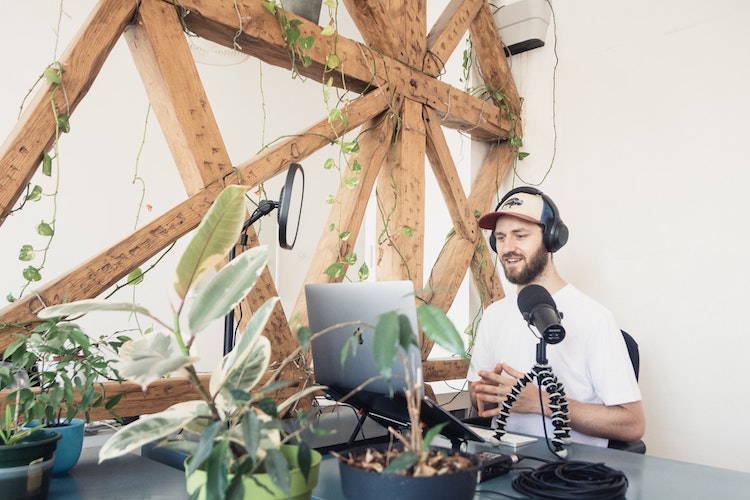
The idea of recording your first episode may seem a bit intimidating if you’re new to podcasting, but implementing a few actions ahead of time can make the session go a lot smoother. Of course, there’s always the possibility that issues may still crop up, but ensuring that you’re well prepared can help lessen your stress if/when they do.
Run through your script beforehand
If you’re like many new podcasters, one of the biggest challenges you’ll likely face when you decide to start a podcast is speaking in an engaging, natural way and not feeling as if you’re talking to yourself. If you don’t have a co-host or a guest on your show, it can be helpful to imagine talking to one person, the kind of listener for whom you’ve created your program.
In addition, be sure to run through your script several times before recording. Although you’ll probably want your script close by while you record, practicing your intro/outro, pauses, where you plan to put extra emphasis, etc. can seriously improve the episode’s flow.
Practicing before you hit the record button also permits you to take care of any last-minute editing of the plan for your episode. As you read through your outline, maybe you’ll realize that a particular point is no longer relevant or you’ll think of something else to add, for instance.
Prepare your recording space
You’ll ideally record your show somewhere that’s as quiet as possible. Once you have your space in mind, consider how you can minimize any potential disturbances before you start recording.
For example, perhaps you have pets that you’ll need to manage or a loud fan on your computer that you might need to replace or keep away from the mic. Be sure to turn off any cell phones and close the windows to shut out any outside noise.
You’ll also want to aim to reduce as much echo as you can. While you can opt to invest in foam panels to place on the walls for sound treatment, this isn’t always feasible for podcasters just getting started. Filling the room with furniture, carpet, and soft objects like curtains and rugs can assist with absorbing sound, resulting in a recording that’s much cleaner.
Pay attention to your microphone technique
Another aspect that can be tricky when you first start your podcasting journey is learning how to speak into the microphone. Get too close to the mic, and you’ll likely have a recording filled with loads of plosives and/or hissing sounds. Put too much distance between you and the mic, and your voice will sound too far away.
Generally speaking, you’ll want to be around 2 to 4 inches away from the microphone to get the best sound, but the exact distance is going to depend on the specific microphone you’re using. Test different distances to determine where to place your mouth in relation to the mic beforehand so that you feel confident when you start to record.
Another tip is to set the mic up at a slight angle rather than directly in front of you, as this can prevent the mic from picking up bursts of air coming from your mouth while you speak. Once you’ve found the perfect placement, try not to move around too much to ensure that your volume level stays consistent.
8. Create your intro and outro
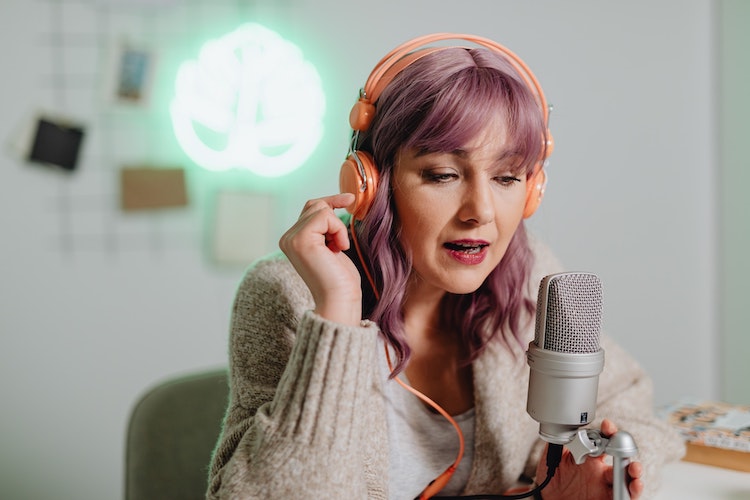
The next step entails creating and the intro and outro for your episode. Although you technically aren’t required to include these elements, they can give your show a bit of personality and another way to stand out from the sea of other podcasts out there. Also known as “bumpers,” intros and outros usually consist of a few seconds of music and brief voiceovers featuring the show’s tagline and information about the podcast.
Getting music for your podcast
Putting a short clip of music, around 10 seconds long, at the beginning and end of your show makes it possible for you to strengthen your branding and add to your program’s professionalism. However, you can’t just use any song you like…
To avoid the risk of copyright infringement and hefty legal fees, you’ll need to search for royalty-free or stock tunes, which you can easily get via sites such as Artlist, Envato Elements, PremiumBeat, Soundstripe, Storyblocks, and others. These music libraries offer a wide range of songs from which to choose, allowing users to purchase them individually or have access to vast volumes of sounds via a subscription.
If you’re musically gifted, you can of course always create your jingle yourself. Another option is to source your music from one of the freelancing sites mentioned earlier, like Fiverr or Upwork to have somebody create a unique music clip for you!
Recording your intro
An engaging podcast intro should entice listeners and make them want to stick around. When crafting your intro, aim to do the following:
- Introduce yourself: Tell those listening who you are, what kind of experience you have, and the value your viewpoint has.
- Explain what your podcast is about: Briefly describe your show’s purpose.
- State why people will want to listen: Let users know how they’ll benefit from tuning in to your program.
- Introduce the episode: Provide a quick preview of what the episode will be about.
Be careful not to make your intro too lengthy, as you don’t want your audience to get bored. A good goal is to aim for 30 seconds or less, including any music you’ve decided to use.
Recording your outro
Your outro serves as a sign-off that allows you to easily transition after the end of the episode. While you can incorporate the same music that you used for your intro, you’ll need to mention different items in your outro:
- Recap the episode: Summarize the main points discussed. You can also add a teaser for an upcoming episode here if you’d like.
- Thank your listeners: Saying thanks to your audience for listening to your program is a great way to show your appreciation and build loyalty.
- Include a CTA: Tell people what you’d like them to do next, e.g., follow you on social media, review your podcast, visit your ecommerce site, etc.
Regarding time, just like with your intro, 30 seconds or less, including your music, is an ideal length for your outro.
9. Edit your podcast
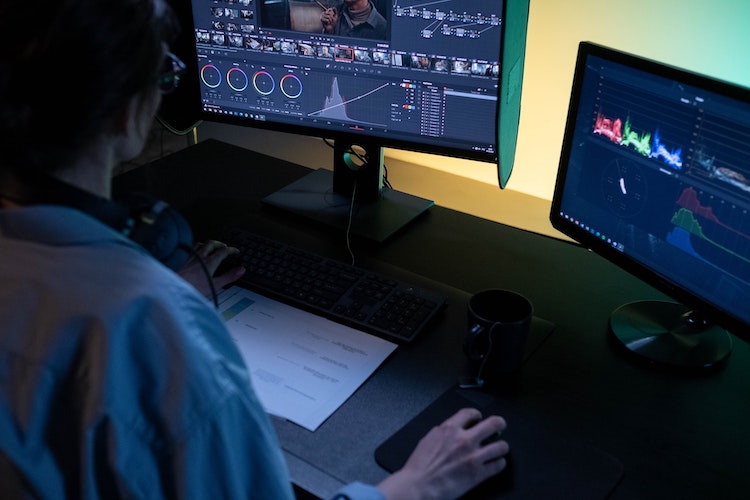
For many podcasters, especially those new to the game, editing is their least favorite phase in the production process. You don’t want to skip this part, though, as it’s what allows you to transform a rough recording filled with awkward pauses, filler words, and tangents into a polished, high-quality show.
Here are a few tips to make this step go as smoothly as possible.
Give your recording a listen before you begin editing
It can be easy to get caught up in removing large blocks of conversations when you edit, only to discover later that you’ve cut out a section that’s essential to the dialogue!
By listening to your audio beforehand, you’ll reduce the chance of cutting out important bits and creating more work for yourself. Be sure to write down the timestamp whenever you notice something you want to edit too.
Split the editing process into two stages
Rather than try to listen for everything in one go, focus your edit on content during your first listen and then on fixing distracting noise issues during the second round. This way, you’ll be less likely to put needless effort into polishing sections that you’ll only end up removing later on.
Aim for a smooth, cohesive listening experience
With your script in front of you, take note of how the conversation flows in the recording compared to the original plan. While going off-script can lead to interesting dialogue, it can also make for tangents that don’t provide any real value.
Don’t be afraid to cut sections that don’t add anything to the episode. Note that removing portions of audio can produce annoying clicks or pops, but using a fade tool at the start and finish of these clips should solve this problem.
Remove distracting sounds
Even if you record in a relatively quiet space, the mic is bound to pick up on all kinds of sounds that can be really distracting to the listener. You’ll therefore want to avail of noise reduction when editing to remove any irrelevant background noise and a high-pass filter to cut out sounds above a specific frequency.
To even out your audio and avoid extreme variances in volume level, be sure to add compression. Remember to also remove lengthy periods of dead air that those listening are likely to easily notice.
Don’t go overboard!
Yes, a polished, professional finished result is the goal, but many podcasters fall into the trap of spending hours upon hours in the editing process, hoping to achieve perfection.
You and/or your guests are probably going to pause and use filler words (“like,” “um,” “kinda,” “you know,” etc.) when speaking. Although you’ll want to remove anything that’ll likely be distracting, avoid doing so much editing that the resulting dialogue sounds completely unnatural. It’s perfectly fine to leave in a few imperfections to keep speakers sounding like humans.
10. Choose your hosting platform
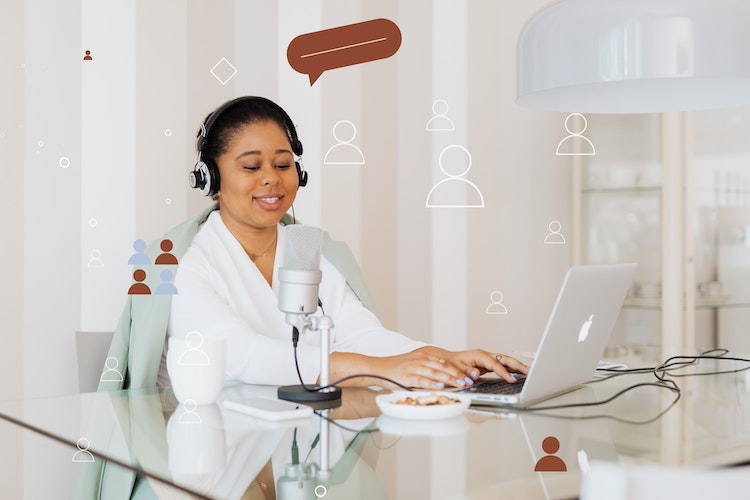
Once your podcast is ready to go, you might think that you’ll next need to upload it directly to sites like Spotify, but this actually isn’t the reality. You’ll instead have to obtain a podcast hosting account, also referred to as a media host, to store your audio files and publish your episodes to podcast directories.
When researching different hosting options, such as PodBean, Buzzsprout, Transistor, Fusebox, Blubrry, etc., you’ll want to consider several factors to determine the right one for your specific needs:
- Storage capabilities: What kinds of storage plans does the platform offer and at what prices? Be sure to think about your storage needs not just for the next few months but also for the long term.
- Website integrations: A website for your podcast can give visitors additional information about your show and the latest episodes as well as tell them more about your brand. It’s important that your chosen media host is able to integrate with your site to ensure that you’re able to upload your recordings as easily as possible.
- Audience analytics: Launching a podcast is a big accomplishment, but at some point, you’ll probably hope to grow your show. Ensure that your hosting platform provides you with detailed insights into your audience engagement and behavior so that you can determine how to improve your offerings.
- Services for content repurposing: Producing a podcast requires a decent amount of effort, so you might as well get as much use out of each of your episodes as possible! Check to see if your media host makes it easy for you to republish your show on other platforms like YouTube and create complete transcriptions of each episode for added accessibility.
After you’ve created your show via your hosting solution, you’ll be able to submit an RSS feed to get your content published on various podcast directories. Any reputable media host should have tools to guide you in the process of submitting your feed or even allow for auto-submission.
Today, there are all kinds of directories available, and you can opt to publish your program on as many of them as you want:
Most require certain details about your podcast, such as the name, category, description, cover art, etc., so it’s beneficial to have all this ready before you get to this part.
11. Get the word out about your new podcast
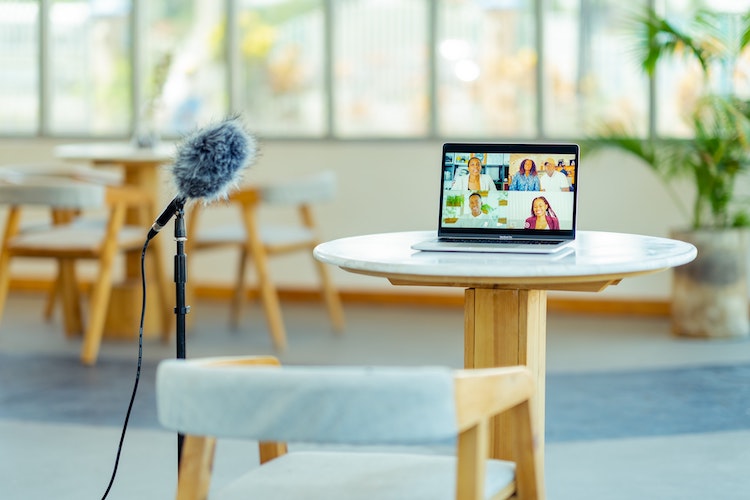
After all the work you’ve put into creating your show, it’s important to let the world know that it exists. Here are a few marketing actions you can take to grow your listenership!
Make a big deal out of your launch
The sooner your program receives listens and reviews, the better, as this increases the likelihood of the various directories spotlighting it. Even if you don’t get featured right away, listens and reviews can assist the organic growth of your podcast.
Build buzz around your launch by creating a podcast website to let visitors know what to expect with your show. Make it possible for people to sign up for your email newsletter to receive updates and news. You can use this to send an email requesting reviews after you launch
Note that launching with just a single episode decreases your chances of getting featured. Debut your program instead with around three episodes to offer listeners a variety of content without overwhelming them.
Share episodes on social networks
Social media offers wonderful opportunities to not just spread the word about your podcast but also to build a community and strengthen your connection with users who listen to your show.
Research which social channels your target market is likely to frequent, and then create engaging posts to pique their interest and get them to check out your program. Tools such as Repurpose.io and Wavve make it easy for you to create visual sound bites to publish on your different networks.
Write show notes to improve SEO
Another marketing strategy to consider implementing is to post show notes on your website. Show notes are written descriptions of what occurred in an episode. They may also include guest bios, extra resources cited in the episode, and other applicable details.
Show notes serve as an additional point of contact between you and your audience. What’s more, when you add relevant keywords to your text, you’ll boost your SEO and increase your chances of getting your site to appear in the search results when users are looking for content related to your niche.
Blog about your show
Blogging, when done well, can be a really effective way to get new audiences to discover your podcast. Besides including show notes on your website, you’ll also want to think about writing blog posts involving topics that tie in to your podcast theme.
For example, you might write an article that goes more in depth with a topic you discussed in a recent episode to provide readers with additional insights. You might alternatively use your blog as an opportunity to interview industry experts and get their thoughts on a particular subject.
Ask your guests to promote your podcast
It’s highly probable that any guests you have on your show have their own communities that follow them. Why not leverage their audiences to spread the word about your program and connect with new potential subscribers?
Collaborating with your guests to promote each other’s work is a fantastic way to foster long-term, mutually beneficial professional relationships and reach even greater levels of success!


![How to start a podcast: The ultimate 11-step guide to success [2026]](https://wizishop.com/media/643eafcb76ecf65e35a222b0/v1/how-to-start-a-podcast-wizishop.jpg)







